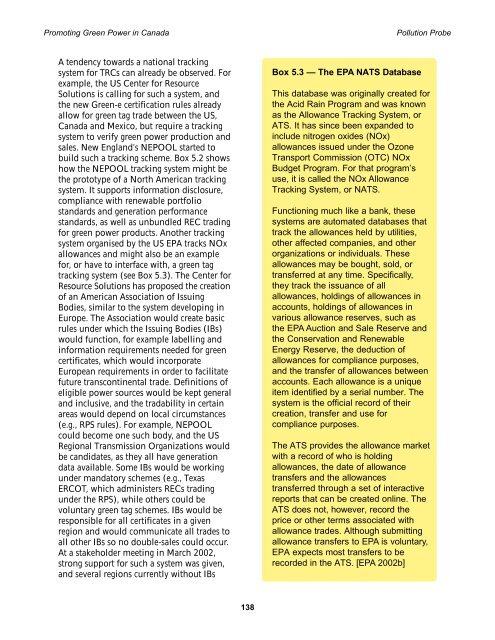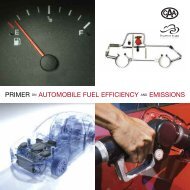Promoting Green Power in Canada - Centre for Human Settlements
Promoting Green Power in Canada - Centre for Human Settlements
Promoting Green Power in Canada - Centre for Human Settlements
- No tags were found...
You also want an ePaper? Increase the reach of your titles
YUMPU automatically turns print PDFs into web optimized ePapers that Google loves.
<strong>Promot<strong>in</strong>g</strong> <strong>Green</strong> <strong>Power</strong> <strong>in</strong> <strong>Canada</strong> Pollution ProbeA tendency towards a national track<strong>in</strong>gsystem <strong>for</strong> TRCs can already be observed. Forexample, the US Center <strong>for</strong> ResourceSolutions is call<strong>in</strong>g <strong>for</strong> such a system, andthe new <strong>Green</strong>-e certification rules alreadyallow <strong>for</strong> green tag trade between the US,<strong>Canada</strong> and Mexico, but require a track<strong>in</strong>gsystem to verify green power production andsales. New England’s NEPOOL started tobuild such a track<strong>in</strong>g scheme. Box 5.2 showshow the NEPOOL track<strong>in</strong>g system might bethe prototype of a North American track<strong>in</strong>gsystem. It supports <strong>in</strong><strong>for</strong>mation disclosure,compliance with renewable portfoliostandards and generation per<strong>for</strong>mancestandards, as well as unbundled REC trad<strong>in</strong>g<strong>for</strong> green power products. Another track<strong>in</strong>gsystem organised by the US EPA tracks NOxallowances and might also be an example<strong>for</strong>, or have to <strong>in</strong>terface with, a green tagtrack<strong>in</strong>g system (see Box 5.3). The Center <strong>for</strong>Resource Solutions has proposed the creationof an American Association of Issu<strong>in</strong>gBodies, similar to the system develop<strong>in</strong>g <strong>in</strong>Europe. The Association would create basicrules under which the Issu<strong>in</strong>g Bodies (IBs)would function, <strong>for</strong> example labell<strong>in</strong>g and<strong>in</strong><strong>for</strong>mation requirements needed <strong>for</strong> greencertificates, which would <strong>in</strong>corporateEuropean requirements <strong>in</strong> order to facilitatefuture transcont<strong>in</strong>ental trade. Def<strong>in</strong>itions ofeligible power sources would be kept generaland <strong>in</strong>clusive, and the tradability <strong>in</strong> certa<strong>in</strong>areas would depend on local circumstances(e.g., RPS rules). For example, NEPOOLcould become one such body, and the USRegional Transmission Organizations wouldbe candidates, as they all have generationdata available. Some IBs would be work<strong>in</strong>gunder mandatory schemes (e.g., TexasERCOT, which adm<strong>in</strong>isters RECs trad<strong>in</strong>gunder the RPS), while others could bevoluntary green tag schemes. IBs would beresponsible <strong>for</strong> all certificates <strong>in</strong> a givenregion and would communicate all trades toall other IBs so no double-sales could occur.At a stakeholder meet<strong>in</strong>g <strong>in</strong> March 2002,strong support <strong>for</strong> such a system was given,and several regions currently without IBsBox 5.3 — The EPA NATS DatabaseThis database was orig<strong>in</strong>ally created <strong>for</strong>the Acid Ra<strong>in</strong> Program and was knownas the Allowance Track<strong>in</strong>g System, orATS. It has s<strong>in</strong>ce been expanded to<strong>in</strong>clude nitrogen oxides (NOx)allowances issued under the OzoneTransport Commission (OTC) NOxBudget Program. For that program’suse, it is called the NOx AllowanceTrack<strong>in</strong>g System, or NATS.Function<strong>in</strong>g much like a bank, thesesystems are automated databases thattrack the allowances held by utilities,other affected companies, and otherorganizations or <strong>in</strong>dividuals. Theseallowances may be bought, sold, ortransferred at any time. Specifically,they track the issuance of allallowances, hold<strong>in</strong>gs of allowances <strong>in</strong>accounts, hold<strong>in</strong>gs of allowances <strong>in</strong>various allowance reserves, such asthe EPA Auction and Sale Reserve andthe Conservation and RenewableEnergy Reserve, the deduction ofallowances <strong>for</strong> compliance purposes,and the transfer of allowances betweenaccounts. Each allowance is a uniqueitem identified by a serial number. Thesystem is the official record of theircreation, transfer and use <strong>for</strong>compliance purposes.The ATS provides the allowance marketwith a record of who is hold<strong>in</strong>gallowances, the date of allowancetransfers and the allowancestransferred through a set of <strong>in</strong>teractivereports that can be created onl<strong>in</strong>e. TheATS does not, however, record theprice or other terms associated withallowance trades. Although submitt<strong>in</strong>gallowance transfers to EPA is voluntary,EPA expects most transfers to berecorded <strong>in</strong> the ATS. [EPA 2002b]138
















